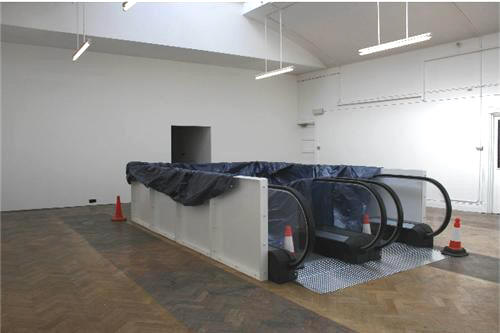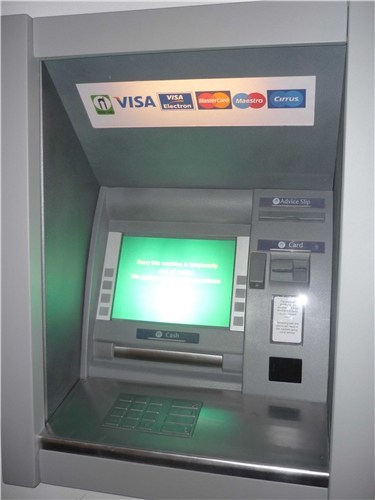|
|
| home | exhibitions | interviews | features | profiles | webprojects | archive |
|
Patrick Lowry's Auction House Sara Bowler
Simulacrum: A thing that replaces reality with a representation, substituting ‘signs of the real’ for the ‘real’ Patrick Lowry is an artist who revels in confounding our expectations. We approach his work believing it is one thing, only to find it is something else, a rendering of surfaces mimicking materials and objects. We hesitate; are we looking at a real thing or a fake? And if it is a fake, how can it be an original work of art? These questions and conundrums resurface throughout Lowry’s career. He uses the art of illusion to create exact replicas of specific objects, often chosen as symbols of political subterfuge or commercial manipulation. At their core is the message; things are not always what they seem.
After gaining a
masters degree in Contemporary Art, he appeared to draw a line under his
early foray into fashioning prototypes, yet Lowry never quite
relinquished his fascination with replicating one material in another.
While his motivations shifted, his approach of meticulous forgery
continued. Mastering the art of rendering one material in another, he
uses his extensive research and making skills to expose neoliberal
“The space it exists in is as much a part of the work as the piece itself.” Patrick Lowry Where the works
are presented is also critical to an understanding of their intention.
The location drives Lowry’s research. Finding out what has happened, or
perhaps as importantly, what might have happened at these sites, enables
him to freeform associations and connections. For
Auction House (2021),
taking place at the appropriately named Auction House Project Space
in Redruth, Cornwall, Lowry has drawn on the building’s original
function as a sale room built in 1880. Through this he reflected on
artworks of significance
Does owning a facsimile of a work of art, forming one tenth of a complete piece, place the buyer within the realm of the contemporary art market? Does it challenge compelling forces inherent in such markets to demonstrate wealth and taste; to launder illicit cash; or to acquire an investment of no aesthetic interest to the purchaser? Auction House will give people an opportunity to decide where they stand in this performance. They will be able to peruse the sale catalogue and make bids in advance and on the day of the auction, vying with others to own a piece of a Lowry, a collection of copies of nine 20th Century artists’ work. He hopes bidding will be fierce! He has plans for the money. Unlike much of the contemporary art market, his (ill-gotten? nobly attained?) gains will be shared between two charities, Sight Savers and Water Aid, longstanding organisations he has previously supported.
Sara Bowler is an artist living and working in Cornwall. Images are works by Patrick Lowry. From top to bottom: American Dream (2013), Escalator 2 (2008) & 24 Hour Cash (2011). See 'exhibitions' for installation shots of 'Auction House' (2021).
|
|
|

 Lowry
is intrigued by consumer objects. He talks of seeing electric guitars in
shops as a youth, attracted to their shiny surfaces and sculptural
forms, drawn by their physical appearance more than any desire to play
them. During his art foundation course, although initially intending to
do Fine Art he became interested in design, intrigued by prototypes that
looked real but did not function. Following a design degree, he joined
Philips Electrical in the ‘70s, dividing his time between Croydon and
Eindhoven but became disillusioned with the ethics of product design.
While attending an international conference in 1973, during the oil
crises examining how to make design sustainable, he concluded the
biggest problem was the designers themselves, intent on only changing
the outward appearance of appliances to entice consumers to buy new
ones. A move to Cornwall to work at Falmouth College of Art and his
subsequent role at Cornwall College leading a Fine Art degree programme,
placed him in a broader, enquiry-driven context where he gravitated back
towards his fine art roots.
Lowry
is intrigued by consumer objects. He talks of seeing electric guitars in
shops as a youth, attracted to their shiny surfaces and sculptural
forms, drawn by their physical appearance more than any desire to play
them. During his art foundation course, although initially intending to
do Fine Art he became interested in design, intrigued by prototypes that
looked real but did not function. Following a design degree, he joined
Philips Electrical in the ‘70s, dividing his time between Croydon and
Eindhoven but became disillusioned with the ethics of product design.
While attending an international conference in 1973, during the oil
crises examining how to make design sustainable, he concluded the
biggest problem was the designers themselves, intent on only changing
the outward appearance of appliances to entice consumers to buy new
ones. A move to Cornwall to work at Falmouth College of Art and his
subsequent role at Cornwall College leading a Fine Art degree programme,
placed him in a broader, enquiry-driven context where he gravitated back
towards his fine art roots.  currents
in all aspects of life within developed economies. Presenting full-scale
replicas of highly valued objects: houses, cars, military drones,
selected 20
currents
in all aspects of life within developed economies. Presenting full-scale
replicas of highly valued objects: houses, cars, military drones,
selected 20 to
him since his art foundation studies, selecting nine artists, a piece of
whose work he would replicate to form a collection of facsimiles to be
sold to the highest bidder. Each simulacrum forms part of the complete
work, underpinned by the performative elements of participants in
viewing, bidding, buying and owning one tenth of the art work. Lowry
invites people to step inside the processes driving the international
art world, where mind boggling sums of money change hands and artist’s
reputations are made or broken. He asks participants to consider the
purpose and value of this activity in relation to the original
intentions of the artists who first made the works he has replicated.
to
him since his art foundation studies, selecting nine artists, a piece of
whose work he would replicate to form a collection of facsimiles to be
sold to the highest bidder. Each simulacrum forms part of the complete
work, underpinned by the performative elements of participants in
viewing, bidding, buying and owning one tenth of the art work. Lowry
invites people to step inside the processes driving the international
art world, where mind boggling sums of money change hands and artist’s
reputations are made or broken. He asks participants to consider the
purpose and value of this activity in relation to the original
intentions of the artists who first made the works he has replicated.